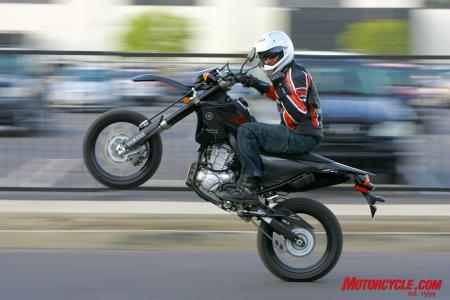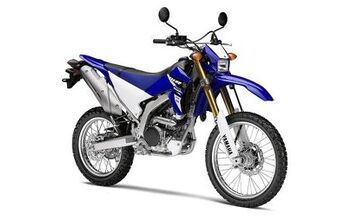2009 Yamaha WR250X Project Bike
Yamaha's WR250X is much more impressive than its modest 250cc engine might suggest. High-tech features such as fuel injection help it crank out more power than even the twin-cylinder-powered Kawasaki Ninja 250 sportbike, especially in terms of torque production. And its upright and accommodating ergonomics keeps a rider comfy whether filtering through traffic or passing tractor-trailer rigs on the 405 freeway.
After giving it a fairly glowing review in our single-bike evaluation, the WR then went head to head against Kawasaki's supermoto contender, the KLX250SF. Although the WR costs $890 more than the KLX, its surplus of power, premium adjustable suspension and sweet aluminum frame made it the clear favorite in our Quarter-liter Supermoto Shootout.
It was so much fun having the WR around we decided to keep it for awhile to judge its overall capabilities. While we were at it, we bolted on a couple of Yamaha accessories to make it easier and more fun to live with.
The most impressive aspect of the WR250X is its dearth of compromises for a quarter-liter, dirt-capable machine (the same platform also underpins the WR250R dual-sport).
Around town, the 250X has more than enough gumption to keep ahead of commuter traffic, but more striking is how well it copes at freeway speeds. Getting to all of our favorite twisty roads requires freeway slogs, so the ability to tolerate high speeds is a necessity. Pacing 80-mph SoCal traffic is no problem for the revvy, liquid-cooled, four-valve motor, and its counterbalancer thwarts annoying vibration that typically accompanies single-cylinder engines.
"Pacing 80-mph SoCal traffic is no problem for the revvy, liquid-cooled, four-valve motor..."
Although the upright dirtbike riding position would seem incongruous with highway travel, the tall gripper seat supplies ample legroom and has plenty of fore-aft space to alter the riding position. A headlight shroud looks like an enduro number plate and deflects a bit of wind from the rider.
The seat is narrower than a traditional streetbike, but its supportive padding allows for a fairly comfortable hour in the saddle before the squirming begins. A 2.0-gallon tank supplies at least 100 miles between mandatory fuel stops, as it's practically impossible to net fuel mileage worse than 50 mpg. Sane riders can easily see 60 mpg and more.
Regardless of its surprisingly capable freeway manners, the WR250X is more in its element while blasting around town or on tight canyon roads. Its commanding view allows a rider to link together gaps in traffic many moves ahead, and its diminutive weight and feline agility inspires confidence to nose it into places unavailable to larger mounts. Big kids who used to sit in the back of the school bus will enjoy the rebellious feeling of blatting around city streets on what is essentially a dirtbike.
The WR's smiles-per-gallon rating is almost off the scale. It's a real pleasure to ride a bike on which you can enjoy the satisfying feeling of pinning the throttle several times during a commute. The WR's compact instrumentation does without a tachometer, but a rider is so fully engaged with a connection to what the motor is doing that it wasn't really missed. The numerals on the digital speedo are just big enough to read quickly.
As a commuter, the WR performs well. Thanks to its electronic fuel injection, it starts quickly and is able to be ridden off without much warm-up time. Quick responses from the MX-style handlebars and a generous amount of steering lock slice up anything in its path.
Wave-style brake rotors front and rear are up to the task of avoiding a texting driver or pulling a mondo stoppie in front of the coffee shop. And 10.6 inches of suspension travel makes the WR a voracious pothole eater. At the end of your ride, secure your lid to the handy helmet lock located aft of the equally handy tool kit.
Commuter duties are hindered somewhat by abrupt clutch engagement and a light-action throttle. And while we're complaining, the WR's six-speed gearbox could be a bit more cooperative. Short people might be intimidated by the 35.2-inch seat height, but it settles closer to the ground with the weight of a rider aboard. Combined with its 299-lb fully fueled weight, the 250X is remarkably easy to manage.
GYTR Slip-on Exhaust
Taking the WR's rebellious attitude one step further was the addition of a slip-on exhaust system. Built by Yamaha's performance accessory division, GYTR (Genuine Yamaha Technology Racing), this superb fitting stainless-steel pipe slips onto the factory exhaust header and easily bolts up using stock fasteners. The brushed aluminum muffler even includes tabs for the factory heat shield.
Like most aftermarket exhausts, the GYTR pipe provides a boost of power at the upper end of the powerband. Thanks to the trusty dyno services of Gene's Speed Shop in Torrance, Calif. (310-704-4544), we were able to see how the restricted stock exhaust chokes the engine and causes power to rapidly tail off after its 8800-rpm peak. Power subsided at the same point with the GYTR pipe installed, but it carried a significant advantage from 9400 rpm all the way to its 11,300-rpm rev limiter.
The accessory pipe also had a surprisingly strong dyno showing at the lower end, outperforming the stock pipe from 3500 to 5200 revs. From there the stock system is better for 800 rpm (perhaps due to its exhaust valve that is lost with the GYTR system), but it spends the following 2000 revs lagging behind until they again intermingle around the 8100-rpm torque peak. From then on, the freer-flowing GYTR system holds a clear advantage.
"Like most aftermarket exhausts, the GYTR pipe provides a boost of power at the upper end of the powerband."
Along with a better powerband, the GYTR exhaust also provides a meaner bark, although it still remains inside noise levels acceptable to our ears. It is said to meet the AMA’s sound requirements, but Yamaha legally has to say the exhaust is for “closed-course competition only.” Its $449.95 MSRP is a reasonable price for improved performance, a lustier sound and a little less weight.
Dynojet Power Commander V
In an attempt to maximize the WR’s engine performance, we decided to install the latest version of Dynojet's successful Power Commander fuel-injection module. The PowCom piggybacks onto a motorcycle’s ECU (the electronic brain) and enables alterations in the fuel flow for optimized responses.
Simple-to-follow instructions are clearly laid out and accompanied by photographs. Installation begins after removing the tank, seat and side covers – a matter of just a few bolts. Other than routing the wiring from the PCV module we mounted behind the instruments, all that's left to do is clip in to the fuel-injector and throttle-position sensors and attach a ground wire to the battery.
Power Commanders are typically sent out with a map to suit bikes in their standard forms, but they can also be ordered with a special map built for engines in various degrees of tune. Maps can also be downloaded from http://www.powercommander.com/.
Our PCV was shipped loaded with a map built around a WR250X fitted with a Leo Vince X3 exhaust with its spark arrestor removed, the best available match at the time for the GYTR system. The addition of the PCV bumped up power in the 4000-rpm range and then closely matched the output from the stock ECU map until 8800 rpm when the PCV tuning offered more power until redline.
Overall, we were only slightly pleased with the dyno results from the $369.95 PCV, but there is a caveat that should be noted. It was only after dyno testing that we realized that the map loaded into our PCV was intended to be used with the bike’s airbox lid removed. We fully expect a stronger pull to redline without the lid's airbox restriction, and better fueling from the PCV to go along with it. Our bad for not testing it properly.
But the PCV has more cool options to go along with improved fueling efficiency. Able to be piggybacked onto the PCV are quickshifters, map selection controls, and an Autotune Kit that automatically adjusts the fuel map while in use if employing an oxygen sensor in the exhaust.
The PCV also allows additional inputs for speed, gear position and boost or temperature sensors that can be used to build maps based around those parameters. A color LCD unit is also available from which you can read engine speed, gear position and other data. Cool stuff, and part of the reason why the Power Commander is the official fuel-injection module of the AMA Superbike Championship.
Yamaha Accessory Tail Bag
Commuting and sport-riding duties are aided by a place to stow supplies, something the standard WR doesn't enjoy. That's why we decided to install a nifty tail bag from Yamaha's accessory catalog. Like all Yamaha accessories, the bag is well engineered to ensure simple installation and a good fit.
The WR’s side covers, seat and rear fender come off after removing just six bolts, and pre-embossed indentations on the underside of the fender serve as a template for the four holes needed to secure the bag. Everything bolts up neatly and easily with nice, durable-looking hardware. Even a hack can do the job in 30 minutes.
The bag is small enough to be fairly unobtrusive yet large enough to be useful for carrying around all sorts of stuff, whether a warm pair of gloves, a rain suit, a cell phone or a beverage. It's conservatively rated at a load limit of just 2.2 lbs but seems able to handle more.
Access inside requires unclipping the main flap and then unzipping the top enclosure. The coolest part of this clever bag is a two-number combination lock that provides a modicum of security. Included in the modest $99.95 price is a waterproof cover with a drawstring closure to keeps your contents dry.
If more stowage space is needed, Yamaha also offers a sturdy luggage rack that holds up to 6.6 pounds ($174.95), and this is required for mounting a slim saddlebag ($179.95) that mounts on the bike's left side and matches the tail bag we installed.
Aside from an assurance of excellent fit, Yamaha's accessories have the added benefit of being able to finance them with the purchase of a bike, adding only a few dollars to a monthly payment.
With the bag supplying a place to stash things, the GYTR pipe providing a little extra power and considerably more street presence, and the Power Commander subtly taming the WR's touchy throttle, we loved having the WR around. It's a breath of fresh air in a world of complicated machinery, and yet its electronic fuel injection, stout and attractive aluminum frame, adjustable suspension and high-tech motor gives it appeal beyond a typical commuter or newbie bike.
Perhaps the best endorsement we can give for the WR250X is that we held onto it far longer than we or Yamaha intended. Its key was often pulled ahead of bikes that are priced two or three times the WR's $6,190 MSRP ($300 extra for 2010).
This is a simple yet seriously fun motorcycle. It can be nearly as riotous running down to 7-11 as it is tearing up a supermoto or go-kart track. And unlike most 250s, there's no need to fear fast highway travel. And with its bad-ass black bodywork, frame, swingarm, rims and fork legs, plus its many high-end features, no one will mistake you for a dweeb who is just looking to save some money on gas.
Now, Yamaha, let's next see a 450cc version!
Related Reading
2009 Yamaha WR250X Review
Quarter-Liter Supermoto Shootout
2009 Honda CRF230M Review
2009 Honda CRF230M vs. 2009 QLINK XF200
2008 Yamaha WR250R & WR250X Review
2008 Lightweight Dual-Purpose Shootout
2008 Aprilia SXV 5.5 Review
2009 Kawasaki Motorcycles Released
Motorcycle.com’s On/Off-road category page
More by Kevin Duke






































Comments
Join the conversation